Facilitator Guide
Facilitator Guide 120514.docx
Logistics Capability Assistance Tool (LCAT)
Facilitator Guide
OMB: 1660-0127
Federal Emergency Management Agency – Logistics Management
Logistics
Capability Assistance Tool (LCAT) Facilitator
Guide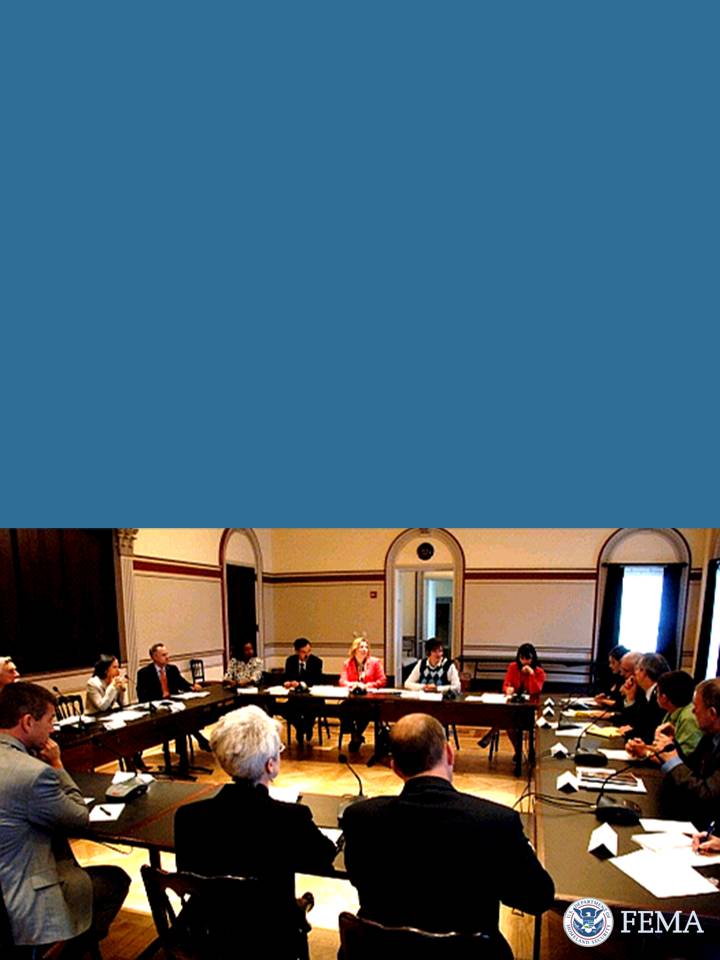
Table of Contents
1.0 INTRODUCTION 1
1.1 Purpose 1
2.0 Authorities 3
2.1 Federal Emergency Management Agency 3
2.2 Logistics Management Directorate 3
3.0 logistics capability Assistance tool background 5
3.1 Logistics Capability Assistance Tool Concept 5
3.2 Logistics Capability Assistance Tool Objectives 5
3.3 Logistics Capability Assistance Tool Structure 6
3.3.1 Logistics Planning 6
3.3.2 Logistics Operations 7
3.3.3 Distribution Management 7
3.3.4 Organizational Functions 7
3.3.5 Property Management 8
3.4 Logistics Capability Assistance Tool Benefits 8
4.0 Workshop Preparation 9
4.1 Workshop Conduct Suggestions 10
4.2 Recommended Participants 11
5.0 Conducting the Workshop 12
5.1 Workshop Structure 12
5.1.1 Administrative Announcements and Introduction 12
5.1.2 Logistics Capability Assistance Tool Demonstration 12
5.1.3 Logistics Capability Assistance Tool Assessment 12
6.0 Navigating the Assistance Tool 14
6.1 Logistics Planning 14
6.2 Logistics Operations 16
6.2.1 Identify Requirements 17
6.2.2 Activate Critical Resource Logistics and Distribution 17
6.2.3 Acquiring Resources 17
6.2.4 Common Operating Picture 18
6.2.5 Procurement 18
6.2.6 Transportation 18
6.3 Distribution Management 19
6.3.1 Resource Tracking 19
6.3.1.1 Transportation Coordination 19
6.3.1.2 Inbound Shipment Management 19
6.3.2 Property Management 20
6.3.2.1 Logistics Equipment Management and Maintenance 20
6.3.3 Commodity Inventory Management Process and Enablers 21
6.4 Organizational Functions 21
6.4.1 Reporting Structure and Alignments 21
6.4.2 Credentialing and Cross-Functional Team Structure 23
6.4.3 Logistics Quality Management 23
6.4.4 Administrative Burden and Jurisdiction Legal Constraints 24
7.0 Post Workshop Actions 25
7.1 Trip Reports 25
7.2 Analysis Reports 25
APPENDIX A: ACRONYMS A-1
APPENDIX B: Resources and References B-1
APPENDIX C: TALKING POINTS ON Logistics Capability Assistance Tool C-1
APPENDIX D: SAMPLE PARTICIPANT INVITATION LETTER FOR THE WORKSHOP D-1
APPENDIX E: SAMPLE WORKSHOP AGENDA E-1
APPENDIX F: SAMPLE WORKSHOP TIMELINE F-1
Appendix G: Sample Participant Thank You Letter G-1
Appendix H: Evaluation and Feedback Survey H-1
Appendix I: Logistics capability Assistance tool introductory briefing I-1
List of Figures
Figure 1: Sample Executive Dashboard Summary 13
List of Tables
Table 1: Recommended Workshop Preparation Timeline 9
Table 2: Proposed Planning Team Composition 14
Table 3: Recommended Follow-up Actions 25
1.0 INTRODUCTION
This facilitator guide is designed to help you, the facilitator, support state, territorial, tribal, and local jurisdictions as they conduct a Logistics Capability Assistance Tool (LCAT) workshop. The contents of the guide are meant to serve as suggestions to assist you through each stage of the workshop, and provide you with helpful hints for interacting with the participants. This guide will also help you explain to them the benefits of LCAT and guide them through the process of responding to the LCAT questions.
Congress directed Federal Emergency Management Agency (FEMA) to develop a program that could be used to improve readiness, increase response capacity, and maximize both the management and impact of homeland security resources. At the direction of the FEMA Logistics Management Directorate (LMD), the resulting LCAT program was developed to enhance state and local jurisdictions’ abilities to determine levels of disaster logistics planning and response capability. The assistance visit results are critical to identifying where to focus additional planning efforts.
To aid in facilitating the workshop and conveying LCAT concepts, this guide was created to assist you with everything from preparing for, scheduling, and conducting the workshop to final follow up and reports. Refer to Appendix C for talking points and Appendix I for a sample presentation to assist you in facilitating an LCAT assessment.
1.1 Purpose
As a collaborative logistics planning and preparedness tool, LCAT can be used to enhance logistics disaster response capabilities and provide a common operating picture (COP) for local, state, regional and federal responders. It is standardized and transportable.
LCAT was created to be used by jurisdictions to evaluate their current disaster logistics readiness, identify areas for targeted improvement, and help develop a roadmap to both mitigate shortfalls and limiting factors, and further enhance strengths. The tool has been developed from the logistician’s perspective and for the logistician’s benefit. Ultimately the jurisdiction and its citizens gain from the resulting increase in logistics capabilities.
The LCAT assessment and associated responses to questions are confidential information, and will not be shared with any other regions, jurisdictions, or agencies, to include Headquarters FEMA. The participating jurisdiction will determine if the assessment results will be disseminated outside the jurisdiction and, if disseminated, to whom they will be available.
Emergency managers at all jurisdictional levels will garner the greatest benefit from conducting LCAT workshops by including as many public and private planning and response partners as possible. A workshop would ideally be conducted in 1.5 days or, if necessary, tailored to meet the jurisdiction’s requirements. Participants should include jurisdiction emergency management officials, FEMA regional and state representatives, FEMA logistics personnel, the National Guard, and private sector partners.
Successful logistics disaster response planning requires all partners to actively contribute to and participate in the assessment. The result will be a more complete and accurate picture of capabilities available for analysis, ensuring a COP that portrays a shared reality. The workshop process itself should promote discussion, awareness, and information flow between the various participants and agencies. The self assessments could be used as a baseline to track overall progress and improvements in specific core competencies. They also help validate successful programs and clearly identify where additional attention may be required.
In fiscal year (FY) 2012, FEMA LMD will transition LCAT program execution to the FEMA Regions, where regional logistics chiefs will continue to make the program available to state and local jurisdictions that wish to participate. In the interim, jurisdictions can either request an assessment facilitated by FEMA personnel, or conduct the self-assessment on their own using the materials provided.
FEMA LMD recommends that the LCAT workshops use an agenda similar to the one in Appendix E. The LCAT questions will likely generate significant discussion, so should diligently manage time. Time has been set aside in the agenda for “parking lot” discussions when participants can revisit and discuss unresolved issues at the end of the day. Also plan to build ample break time in to the agenda.
2.0 Authorities
The following subsections define the roles of the authorities responsible for the LCAT program.
2.1 Federal Emergency Management Agency
FEMA’s mission to reduce loss of life and property and protect communities nationwide from all hazards is the impetus for LCAT. To serve disaster survivors and communities more quickly and effectively, FEMA builds on experience, applies lessons learned and best practices from field operations, and gathers feedback from many sources to constantly improve upon its operational core competencies, of which disaster logistics is one.
FEMA implements 21st century logistics and procurement systems to help efficiently and effectively plan, identify, track, and distribute supplies needed by disaster survivors, emergency responders and other users on the ground. Working with an array of public and private strategic partners, donors, and pre-arranged contractors, FEMA provides improved logistics integration and customer support.
2.2 Logistics Management Directorate
FEMA LMD plans, manages, and sustains national logistics response and recovery operations in support of domestic emergencies and special incidents. LMD establishes national procedures, fosters transparency through collaboration and coordination and is focused on technology enhancements to expand region and state level logistics capabilities. LMD is organized around the following four core competencies:
Logistics Plans and Exercises - Develops and provides cohesive and synchronized logistics plans and exercises to achieve both short and long term readiness requirements. Ensures deliberate planning efforts result in coordinated concept of operations (CONOPS) and plans that define repeatable processes. These processes support optimized national logistics response and recovery operations supporting domestic emergencies and special incidents.
Logistics Operations - Manages and executes national logistics command and coordination, tracking, and reporting for all-hazard operations. Stores, maintains, and deploys temporary housing units.
Distribution Management - Manages a comprehensive supply chain, warehouse, and transportation operation using a strategic alliance to effectively and efficiently distribute supplies, equipment, and services to support emergencies.
Property Management - Provides management oversight, internal control, and technical reviews in the areas of property accountability, reutilization, and disposal of disaster operations equipment. An enterprise-wide property accounting and asset visibility system that is designed to ensure best value is implemented.
LMD’s strategic direction includes people, customers, processes, and systems, outlined as follows.
People - Develop a professional logistics workforce, including regional staff, through hiring, training, credentialing and professional development; foster an accountability and results based culture.
Customers - Develop collaborative relationships with key stakeholders; foster both horizontal and vertical coordination; and develop bottom up requirement processes.
Processes - Modernize and integrate the national supply chain network, institute logistics planning to enhance response capability, develop and document key business policy and processes, perform analyses, and take a systematic approach to task and issue resolution.
Systems - Modernize the logistics system network; upgrade and fully integrate our systems to achieve maximum capability effectiveness.
3.0 logistics capability Assistance tool background
3.1 Logistics Capability Assistance Tool Concept
LCAT is comprised of over one hundred survey-style questions grouped into functional capabilities within five core competencies. As a facilitator, you should encourage participants to respond to each question with complete honesty, by identifying where the jurisdiction fits along a range of five capability levels, from static to synchronized. The goal of this assessment is to determine where a particular capability falls within the levels defined below:
Static – The jurisdiction has not yet developed and/or implemented a viable strategy within the functional area.
Functional – The jurisdiction has implemented informal plans or processes, but standard operating procedures (SOP) have not been defined or adopted.
Horizontal Integration – The jurisdiction has developed and implemented formalized, integrated SOPs across its emergency management (EM) organization.
External Collaboration – The jurisdiction has coordinated plans and SOPs with other state, local or tribal, and external partner agencies, organizations, and private vendors.
Synchronized – All partners (local, state, federal, and private, as applicable) have fully integrated and synchronized plans, procedures, and operations. All plans and SOPs have been documented and exercised regularly with all participants. The jurisdiction has demonstrated mastery of this capability.
Using a standardized approach and validated measurement criteria, LCAT objectively evaluates jurisdictional capability to perform basic logistics response and recovery functions and targets specific areas that need improvement. These capability levels should not be equated to a 1-5 scoring system, and the top-most level is not always the best fit for a jurisdiction. There is a “Not Applicable” option for all questions, so jurisdictions should not feel compelled to give themselves the highest marks in every category. If the question is not indicative of a capability appropriate for the jurisdiction, “Not Applicable” could be the most appropriate response.
3.2 Logistics Capability Assistance Tool Objectives
LCAT is designed to improve the COP for local, state, and federal responders—identifying any gaps between the current state of preparedness and the desired state of preparedness. An added benefit of LCAT and the LCAT workshop concept is the inherent collaboration and common operating picture achieved among state, local, regional, other agency, and private-sector partners who participate in the workshops. Stakeholders will gain a more complete understanding of roles, responsibilities, and dependencies; strengthen and build upon existing relationships; and foster new logistics response partnerships. Implementing the tool requires state personnel to work closely with counterparts from other state agencies, the FEMA region, and other stakeholder organizations. Sharing information about logistics plans, operational SOPs, and federal, public, and private partner roles and responsibilities not only enhances transparency, but also builds trust among the partners. In addition to the above, the following objectives are also part of the LCAT program:
Develop a standardized, transportable tool to identify logistics response strengths and weaknesses;
Develop a roadmap for continually improving planning and response capabilities;
Serve as a tool to guide further detailed planning;
Serve as a tool to tailor education and training to specific areas that will enhance response capability;
Meet Congressional intent to develop a demonstration program to enhance jurisdiction disaster response capability and use public-private partnerships;
Focus on and evaluate jurisdiction logistics preparedness, planning, and disaster response functions;
Highlight disaster logistics best-practices;
Identify opportunities for tailored education and training;
Identify planning and response capabilities and provide a common understanding of the jurisdiction’s readiness;
Track improvements in particular functional capabilities; and
Enhance jurisdictional response capability and public-private partnerships.
Jurisdictions of any size can use LCAT to evaluate their current disaster logistics readiness, identify areas for targeted improvement, and develop a roadmap to both mitigate weaknesses and further enhance strengths.
3.3 Logistics Capability Assistance Tool Structure
The source of the assessment is a survey-style question set, comprised of questions grouped by core competencies and further broken down according to the functional capabilities listed as follows.
3.3.1 Logistics Planning
Questions were developed to consider demand recognition, sourcing, acquisition, transportation, warehousing requirements, and distribution or management of goods, people, and equipment during a disaster. The following functional capabilities within the logistics planning core competency are addressed:
Plans development,
Contingency planning,
Distribution planning,
Training and compliance,
Provider qualification,
Procurement procedures and protocols,
Solicitation, and
Existing contracts.
3.3.2 Logistics Operations
These questions address logistics procedures. Logistics operations ensure that SOPs and processes support established action plans. The following functional capabilities within the logistics operations core competency are addressed:
Identify requirements,
Activate critical resource logistics and distribution,
Acquire resources,
COP,
Procurement, and
Transportation.
3.3.3 Distribution Management
The end-to-end movement of people, commodities, and equipment is critical to any disaster response. Response includes communications with other stakeholders, ordering, order processing, transportation asset identification and dispatch, delivery receipt, and delivery confirmation. The following functional capabilities within the distribution management core competency are addressed:
Order tracking,
Transportation coordination, and
Inbound shipment management.
3.3.4 Organizational Functions
Disaster response logistics is a key component of emergency management and considers training, credentialing, logistics resource acquisition, general administration, and quality management. The following functional capabilities within the organizational functions core competency are addressed:
Reporting structure and alignments;
Credentialing and cross functional team structure;
Logistics quality management;
Logistics knowledge, skills, and training;
Administrative burden; and
Jurisdiction legal constraints.
3.3.5 Property Management
Property management includes the inventory management processes, in-transit visibility activities, and capital asset and commodity maintenance. The following functional capabilities within the property management core competency are addressed:
Property management personnel,
Warehouse and facility management,
Logistics equipment management and maintenance, and
Commodity Inventory Management Process and enablers.
3.4 Logistics Capability Assistance Tool Benefits
Providing participants with a list of clear benefits derived from the LCAT process will help them stay fully engaged. The benefits are:
Increased transparency, collaboration, and partnership throughout state, territorial, tribal, local, and federal governments;
Improved state relationships with private partners;
Comprehensive analysis reports provided to jurisdictions;
LCAT analysis reports feed into incident action plans and after-action reports—ultimately improving plans and mitigating risks;
Enhanced state and regional COP;
Increased understanding of the logistics mission and best practices for end-to-end supply chain stakeholders; and
By identifying capability gaps and maturity levels, jurisdictions can improve overall logistics capabilities.
4.0 Workshop Preparation
As the facilitator, determine your facilitation team composition and help the jurisdiction prepare for your visit. At a minimum, a facilitation team should include a facilitator, an analyst/technical writer, and a logistics subject matter expert (SME). The entire facilitation team should have a solid understanding of LCAT. Refer to the LCAT user instructions on how to operate the LCAT application.
As soon as possible, request that the jurisdiction identify a point of contact for you to work with, from pre-planning to completion of the trip report. In addition, the facilitator should work with the jurisdiction’s point of contact to ensure the appropriate participants are invited to attend the workshop. Depending on the complexity of the jurisdiction, a back-up facilitator, recorder, or SME might be needed. In the months and weeks prior to the workshop, ensure the actions in Table 1 are completed.
Table 1: Recommended Workshop Preparation Timeline
Timeline |
Action |
Initial contact |
Ensure the jurisdiction understands LCAT capabilities and starts to prepare for the assessment workshop. |
2 months in advance |
Assist the jurisdiction in proposing and confirming dates for the workshop. |
1-2 months in advance |
Book or confirm travel reservations. |
1 month in advance |
Ensure that you have sufficient stock of LCAT workbooks and CDs. |
2 weeks in advance |
Coordinate travel requirements. |
1 week in advance |
Send the jurisdiction the LCAT application and appropriate content guide (state or local). Verify receipt. |
A workshop location should be selected that is conducive to face-to-face discussions. Ensure that there is enough space and appropriate seating, lighting, heating, ventilation, and air conditioning capability. A theater style room or an operations center would not be an appropriate facility. Other considerations include ensuring that appropriate information technology (IT) capabilities will be available and that there is an IT expert available to address any potential issues that may arise.
Prior to the workshop, ensure that the following items are provided to the jurisdiction point of contact:
LCAT application CD,
LCAT Content Guide, state or local as appropriate.
The facilitator should ensure that the workshop items listed above are mailed or delivered to the jurisdiction point of contact.
The workshop should begin with an introductory briefing provided by you. Introductions, administrative details, and the presentation should take about an hour. Your presentation should include administrative comments, LCAT background and objectives, the benefits of the assessment, what the assessment process entails, and a review of the workshop agenda. Refer to Appendix E for a sample workshop agenda you can tailor and personalize for your audience. Refer to Appendix F for a sample workshop timeline.
4.1 Workshop Conduct Suggestions
As the facilitator please keep the following tips and workshop conduct suggestions in mind throughout the workshop.
Remind participants that the only right answer is the honest answer.
Encourage all meeting attendees to participate. Everyone invited to attend the workshop should have valid opinions and insights. The group benefits from dialogue and discourse, as it tends to illustrate some of the nuances of disaster response logistics processes.
Keep conversations focused on the topic of discussion and save cross-talk discussions for more appropriate times.
As you lead the participants through the assessment ask leading questions rather than questions that can be answered with “yes” or “no” to help them focus their thoughts.
In the event that consensus is not reached in a reasonable amount of time, unresolved issues will be set aside to the “parking lot,” to be addressed later. Using any remaining time to continue discussions, parking lot issues can be addressed after all of the other questions have been answered.
In addition to the recorder who will be annotating responses to questions in LCAT, you should assign a member of the facilitation team to track and note recommended improvements to LCAT for the hot wash at the end of the workshop. You could also request that the jurisdiction point of contact select someone for this task.
As you conduct the workshop, make sure that everyone fully understands commonly used terms. For example, the term “collaborative planning team” could mean different things to different people. Providing the definition at the beginning of and throughout the workshop will help avoid confusion.
During the hot wash at the end of the workshop, a summary of discussions, responses, action items, and parking lot issues will be reviewed.
Keep track of and note potential improvements to LCAT from your point of view and suggestions from the audience. The FEMA LMD team is very interested in your input and/or suggestions for improving the assessment process.
It is important to check with the jurisdiction point of contact before you leave home to confirm that copies of the appropriate LCAT content guide (state or local) and LCAT application CD are distributed to participants attending the workshop. Even though you will have already mailed copies to the jurisdiction, it may be helpful to travel with one or two extra copies. The documents that you provided should facilitate a consistent approach and message, though participants may have different perspectives.
4.2 Recommended Participants
Jurisdictions of any size can use LCAT to evaluate their current disaster logistics readiness, identify areas for targeted improvement, and develop a roadmap to both mitigate weaknesses and further enhance strengths. Participants who should attend the assessment include state emergency management officials, FEMA Regional representatives, local emergency managers, National Guard representatives, and private-sector partners. Bringing together all partners involved in disaster logistics planning and response ensures more complete and accurate responses to LCAT and promotes discussion, awareness, and information sharing between the various agencies. The following individuals and organizations are highly recommended to participate in the assessment.
FEMA State Federal Coordinating Officer
FEMA Regional Logistics Chief
State Emergency Management Director
State logistics chief and support staff
State operations chief and support staff
State planning chief and support staff
State mass care and sheltering support staff
Other key emergency management agency staff
State procurement officer(s)
State finance and accounting officer(s)
National Guard personnel
Major private-sector contractors
Key state non-governmental organizations
County emergency management officials
City emergency management officials
The more decision makers in attendance during the assessment, the better, as one of the most beneficial aspects of LCAT is the inherent educational nature of the tool. A sample participant invitation letter can be found in Appendix D.
5.0 Conducting the Workshop
This section serves as guidance in conducting the workshop, but can be changed or tailored to meet the jurisdiction’s needs.
5.1 Workshop Structure
The following subsections provide the suggested structure of the workshop.
5.1.1 Administrative Announcements and Introduction
As mentioned earlier, during your introduction presentation, you should start with administrative comments such as a welcome, layout of the facility, safety comments (evacuation, tripping hazards, etc.), and introductions.
During the presentation, emphasize that the tool has been developed from the perspective of state, territorial, tribal, and local logisticians for their benefit. Emphasize that all responses to the questions are, and will remain, confidential and will not be shared with any other jurisdictions or agencies. The jurisdiction being visited will determine who receives a copy of the results of the assessment. If participants understand their answers are confidential, they should be more willing to provide honest answers.
You should also address LCAT objectives, benefits, the assessment process, and the agenda. A copy of the presentation can be found in Appendix I. Feel free to modify the presentation to personalize it for your audience.
5.1.2 Logistics Capability Assistance Tool Demonstration
After the introductory presentation, you or a facilitation team member should demonstrate the interactive LCAT program. You should address any questions that participants might have at this time.
5.1.3 Logistics Capability Assistance Tool Assessment
Next, review designated responsibilities expected throughout the workshop and then start the assessment by addressing each question individually. The preparation you have done and your understanding of disaster response logistics, LCAT, and the content guides will be important at this point in the workshop.
The LCAT guides will be as helpful to you as they should be to the participants. They address each question by providing the intent behind the question and an approach for responding to the question. Also, by being familiar with the content guides you have a better understanding of the thoughts behind the questions.
Your role is to help guide the participants through the assessment and answer questions as they progress. Each LCAT question provides an in-depth, graduated set of possible responses. In this collaborative workshop setting encourage meeting participants to consider and discuss each question and agree on a current level of process maturity.
A technical writer or recorder should be present to type participant responses directly into the LCAT application. The recorder should have excellent typing skills and, ideally, an understanding of disaster response logistics to ensure all information is properly documented. In addition to helping participants use LCAT during the workshop, you should teach participants how to conduct self assessments on their own, so it is important to mention the benefits of doing self assessments periodically.
After all questions are answered within a core competency, LCAT generates a results chart which provides a snapshot of where the jurisdiction’s relative strengths and weaknesses lie within each functional capability. Instructions for retrieving reports and graphs can be found in the LCAT User Guide. When each core competency is completed, the tool generates an Executive Dashboard Summary of overall capability levels. A snapshot of the Executive Dashboard Summary is depicted in Figure 1.

Figure 1: Sample Executive Dashboard Summary
LCAT provides results after all questions have been answered for each core competency. Each of the functional capabilities and questions is automatically processed, and a valuation is derived for each section as well as the overall capability.
6.0 Navigating the Assistance Tool
LCAT allows the user to assess the following core competencies: logistics planning, logistics operations, distribution management, organizational functions, and property management. Reading the following background information on each of these core competencies will help to prepare you to facilitate the actual assessment.
6.1 Logistics Planning
It is important for the facilitator to focus solely on planning during this timeframe given that following sessions focus on execution. This segment should take approximately three hours, with a lunch break between the morning and afternoon periods.
While logistics planning is recognized by most state, territorial, tribal, and local jurisdictions as a critical capability, sufficient plans and resources to conduct planning remain a challenge. The 2006 Nationwide Plan Review: Phase 2 Report stated, as an area of relative weakness, that “very few plans adequately address the processes or procedures that are needed to respond to a catastrophic event.” LCAT is designed to assist jurisdictions in logistics planning.
Experience and lessons learned indicate emergency planning is best done by a team. Utilizing a team of stakeholders working in a group environment helps response organizations define their perception of the disaster/emergency situation and the role each stakeholder will play. It is important for emergency planners to take advantage of other stakeholders’ experience and knowledge. They are encouraged to form a collaborative logistics planning team to address emergency preparedness and response activities.
In most jurisdictions, the designated emergency manager is the senior elected official’s policy advisor for all aspects of mitigation, preparedness, response, and recovery strategies. In this role, emergency managers are often responsible for coordinating and developing the overall Emergency Operations Plan (EOP). The local emergency management agency is responsible for creating the logistics planning team, which should include the individuals or organizations identified in Table 2.
Table 2: Proposed Planning Team Composition
Individuals/Organizations |
What They Bring to the Planning Team |
Emergency Management Agency |
Knowledge of resources and resource request process |
Social Services Department |
Personnel resources |
Department of Health |
Subject matter expertise; medical preparedness, health information technology, medical supplies, response team |
Parks and Recreation Department |
Provide life support and other services |
Public Works Department |
Personnel resources |
Fire Department |
Fire suppression, traffic control, safety, hazardous material response |
Police Department |
Law enforcement, security, safety, traffic control, search and rescue |
Representatives of Volunteer Organizations Active in Disaster |
Assist in point of distribution (POD) operations |
Department of Transportation |
Equipment support, transportation and shipping management |
Community Emergency Response Team |
Material management |
Private-sector liaison to business |
Provide supplies and support POD and staging area |
The planning team should be multi-jurisdictional, so counties and municipalities can plan to effectively share resources. Regional planning is also critical for large metropolitan areas that may rely on assistance from neighboring cities during an emergency. Local and regional planning should be integrated with federal efforts, so that if federal resources are requested, state, territorial, tribal, and local governments are fully prepared to accept and use the resources.
The following planning process has enough flexibility for each jurisdiction to adapt it to fit the jurisdiction’s unique characteristics and situations. Smaller communities can follow the steps appropriate to their size, known hazards, and available planning resources. Comprehensive Preparedness Guide (CPG) 101 establishes the following numbered planning steps:
Form a collaborative planning team
Identify core planning team
Engage the whole community in planning
Understand the situation
Identify threats and hazards
Assess risk
Determine goals and objectives
Determine operational priorities
Set goals and objectives
Plan development
Develop and analyze courses of action
Identify resources
Identify information and intelligence needs
Plan preparation, review, and approval
Write the plan
Review the plan
Approve and disseminate the plan
Plan implementation and maintenance
Exercise the plan
Review, revise, and maintain the plan
CPG 101 also provides emergency managers and other emergency services personnel with Department of Homeland Security’s (DHS) best judgment and recommendations on how to address the entire planning process, from forming a planning team to writing and maintaining the plan to executing the plan. Planners should consult the CPG 101 for basic information on the steps listed above.
6.2 Logistics Operations
About an hour and fifteen minutes should be allotted to discussing logistics operations on the first day of the workshop, after logistics planning. At the end of the day, a forty-five minute parking lot discussion should be scheduled for participants to discuss any issues that were not resolved during the day.
The type and quantity of commodities the public will need in the aftermath of an incident will vary due to many factors. While no two incidents are the same, there are some common essential items required for public health, safety, and lifesaving needs. They include potable water (usually bottled), pre-packaged, shelf-stable foods, and other supplies. During localized incidents, and initially during larger disasters, these commodities are normally supplied by state, territorial, tribal, and local governments or through the efforts of volunteer agencies, such as the American Red Cross and the Salvation Army.
When the need for commodities exceeds the state, territory, or tribe’s capability, under a Presidential declaration, these entities can request that FEMA provide the additional requirements. FEMA LMD will provide commodities stored in distribution centers in various locations, and if needed, coordinate with the National Response Framework (NRF), Emergency Support Function (ESF)-3, to purchase additional quantities of water and power generation equipment. These commodities and supplies are most often delivered in over-the-road tractor-trailer loads.
Once assistance from FEMA is requested and approved, staging areas supply the local PODs in the jurisdictions affected by the incident. The titles of the staging areas may change from jurisdiction to jurisdiction so participants may be familiar with other names such as state staging area or regional staging area. It is incumbent upon each state, territorial, tribal, and local jurisdiction to prepare plans that implement and support the distribution of necessary commodities to the public. At a minimum, plans for accomplishing this should include:
Assigning an agency or department with the primary coordinating responsibility for logistics distribution planning and implementation;
Identifying PODs and sources to secure material handling and support equipment prior to an incident (if advance warning is available);
Assigning roles and responsibilities, to include staffing and equipment requirements, for each agency or department with an assigned role in logistics distribution; and
Identifying staffing gaps.
6.2.1 Identify Requirements
After an incident, compare available resources (possessed by the jurisdiction directly as well as available through contracts or mutual aid) with the emerging needs. Once resources have been identified, determine what additional resources are needed for response efforts (96+ hours in advance of anticipated needs if possible). What and how much is needed? Where and when is it needed? Who will be receiving or using it? Some of these requirements can be estimated prior to an incident based on the jurisdiction’s hazard analysis, previous incidents and operations, demographic profiles, and approved models. Planning matrices, such as the one developed by the United States Army Corps of Engineers (USACE), can also help emergency management personnel determine the resources necessary to assist affected populations. In the end, the amount of resources ordered should not exceed the capability of the jurisdiction to store and distribute them.
6.2.2 Activate Critical Resource Logistics and Distribution
The key factors to remember for active critical resource logistics and distribution are:
SOPs for jurisdiction staging area operations and POD operations should be developed.
Jurisdiction plans should include instructions for reducing or ending POD operation when no longer needed.
Ensure the jurisdiction is aware of Independent Study (IS) Course IS-26, Guide to Points of Distribution.
6.2.3 Acquiring Resources
When possible, resource requirements should be filled by the lowest level of government that has resources readily available and managed by the local emergency manager. If the entity receiving the request does not have adequate resources, a request should be submitted to the local Emergency Operations Center (EOC) or multiagency coordination system using standardized resource-ordering procedures. If the local EOC is unable to fill the order, the request should be forwarded to the next level—generally the state, territorial, or tribal EOC. The jurisdiction determines how or if the requirement can be fulfilled by state, territorial, or tribal agencies; private-sector groups; or through mutual aid such as the Emergency Management Assistance Compact (EMAC) or the Statewide Mutual Aid Agreement.
If the state, territory, or tribe cannot fill the need, it submits an Action Request Form requesting federal assistance. Tribal governments have the option of requesting assistance from the state prior to seeking federal assistance if they so choose. Managers should encourage jurisdictions to make requests by identifying specific needs rather than specific resources. Often a particular resource is not available, but a similar resource will address the need sufficiently. Communities can also benefit from developing a series of pre-scripted mission requirements outlining the needs that would likely result from different types of incidents. When determining how many resources to request, planners should consider changes to population size due to evacuations, as well as commodity requirements for first responders and base camps. Situation reports will help provide information to inform these decisions.
6.2.4 Common Operating Picture
Jurisdiction logistics personnel should be provided access to the COP and purchasing information should be integrated into the logistics COP.
6.2.5 Procurement
These key points should be considered for procurement;
Purchasing training should be incorporated into the jurisdiction’s disaster logistics.
Jurisdiction lead-time standards for mission assignments should be available.
The jurisdiction should employ a first-in, first-out commodity sharing and visibility structure with neighboring counties and neighboring states.
Key jurisdiction logistics personnel should understand the federal procurement reimbursement program.
6.2.6 Transportation
When directed to mobilize resources, the authorizing agency or person must be given the following information regarding transportation:
Date, time, and place of departure;
Weather and other local conditions;
Mode of transportation to the incident;
Estimated date and time of arrival;
Reporting location (address, contact name, and phone number);
Anticipated incident assignment, anticipated duration of deployment; and
The resource order number, incident number, and applicable cost and funding codes.
When resources arrive at the scene, they must be logged into the system. The on-scene processing system should also confirm to the sender that the resource has been received.
6.3 Distribution Management
The second day of the workshop should begin with a ten minute overview of the first day’s discussion. The distribution management section should take approximately one hour. Considerations for this discussion are explained in the following subsections.
6.3.1 Resource Tracking
Resource tracking is a standardized, integrated process conducted throughout the life cycle of an incident. It provides a clear picture of where resources are located and helps staff prepare to receive them. Procedures to track resources continuously from mobilization through demobilization should be established, and real-time information should be displayed in a centralized data base allowing total visibility of assets. The following methods and systems can be used to collect, update, and process data, track resources, and display the readiness status of resources:
Any requirements for en route check-in (by time, by location, etc);
Geographical Information Systems (GIS);
Resource tracking systems;
Transportation tracking systems;
Inventory management systems; and
Reporting systems.
6.3.1.1 Transportation Coordination
These are key factors to be considered for transportation coordination:
Transportation providers (carriers) should be selected using multi-factor criteria.
A clearly defined lead agency and coordinator for transportation should be identified and the transportation coordinator’s role defined.
Established jurisdiction contracts and agreements with public or private transportation providers should be created, if legally permissible.
Identify when transportation assets provide a status or location update and determine how to manage how carriers are assigned loads.
The jurisdiction should have in-transit visibility capability and consider, when required, whether or not security escorts could be utilized for critical loads.
6.3.1.2 Inbound Shipment Management
There should be a measure of coordination between inbound and outbound shipment scheduling at a majority of the distribution locations. Inbound shipments should be scheduled or managed to control the flow into distribution points to prevent queues and backlogs.
6.3.2 Property Management
Approximately 45 minutes are allotted for this session, which will address the areas below. Jurisdictions should designate primary and support staff for warehouse operations, loading and unloading, inventory, tracking, mission tasking, and other tasks related to staging area operations. If additional assistance is required, personnel and equipment can be obtained through local, intra-state, and EMAC mutual aid agreements. The National Guard, state, or federal forestry, and other applicable entities can help supervise and administratively manage a staging area upon request. A commercial firm can also be hired to help establish, manage, and operate the staging area, though overall site management must be under the direction and control of the county or municipal EOC. In addition to the above, the following positions are ideally filled for successful operations of a staging area:
Manager,
Planning unit leader,
Ordering unit leader,
Ground support unit leader,
Transportation unit leader,
Communications unit leader,
Safety officer,
Ground support unit,
Ordering unit,
Accountable property officer,
Transportation unit,
Planning unit, and
Communications unit.
6.3.2.1 Logistics Equipment Management and Maintenance
The key factors to consider for logistics equipment management and maintenance are:
The jurisdiction should consider having the equipment necessary, including material handling equipment (MHE), to warehouse commodities and deploy commodities to impacted populations during the first 72 hours post-incident.
The best method to describe the level of visibility the jurisdiction has over organic logistics equipment should be established.
Jurisdiction-owned equipment (e.g., MHE), maintenance status, and operational status should be actively documented and monitored.
Develop a process that addresses an appropriate level of visibility over leased (contracted) logistics equipment.
Determine the best method to describe the jurisdiction’s maintenance requirements for leased (contracted) logistics equipment.
Organic fixed generator scheduling, maintenance status, and operational status should be tracked, if applicable.
Organic portable generator scheduling, maintenance status, and operational status should be tracked, if applicable.
6.3.3 Commodity Inventory Management Process and Enablers
Without knowing how many state, territorial, tribal, and local resources are readily available (including facilities such as PODs and staging areas), emergency managers have no way to determine how much federal support, if any, is necessary. All resources available for deployment should be entered into a resource data base, and the data should be made available to 9-1-1 centers, EOCs, and multi-agency coordination entities.
When determining what resources should be kept on hand at all times, consider the urgency of need during a disaster, whether the commodity can be produced quickly, and the shelf life or maintenance requirements of the inventory. When storing resources, there must be sufficient funding in the budget for replenishments, preventive maintenance, and capital improvements. Property belonging to a specific agency should be accounted for during the inventory process in accordance with local property management regulations and policies.
It is also important to release invitations to bid and requests for proposal, if legally permissible, for contingency contracts prior to an emergency. These contracts and agreements should be reviewed annually and adjusted as needed.
6.4 Organizational Functions
The following subsections describe the organizational functions.
6.4.1 Reporting Structure and Alignments
This session should last for approximately 50 minutes. Jurisdictions should identify key functions that state or local agencies will accomplish during an emergency, including the roles that federal, state, territorial, tribal, local, regional, and private-sector agencies will take to support local operations. Logistics management during disaster operations is conducted primarily within the logistics section (or responsible ESF) as detailed in the EOP. When assigning roles and responsibilities, first determine what section, agency or jurisdiction will lead the logistics management function. The lead agency, or ESF if applicable, is responsible for determining ongoing logistics management actions (including plans and execution) and coordinating all participating agencies or ESFs.
The jurisdiction may assign the lead or coordinating role to a specific department or agency based on the respective community’s emergency response structure. For example, a county purchasing department may lead the logistics function in the EOC. The lead section, agency, or jurisdiction also provides the logistics section chief, whose role will be discussed at greater length later. Special consideration needs to be made if any responsibilities will be tasked to private vendors or voluntary agencies. In addition to determining the lead, jurisdictions must decide what sections or agencies will manage the following functions and explicitly assign responsibilities to those sections and agencies by name within the plan:
Transportation
Provides assistance for transportation prioritization and tracking
Arranges for transportation services of relief supplies
Provides staff for the staging area as directed
Coordinates and provides oversight of movements (e.g., assigning loads to carriers or balancing inbound and outbound shipments from staging areas)
Receives and appropriately forwards requests for waivers
Assists in routing to avoid hazards or otherwise impassable areas
Communications
Contracts telecommunications support
Provides telecommunications, radio, and other related services
Supports communications requirements of the staging area and PODs
Resources Support
Requisitions or contracts for supplies and equipment
Leases, rents, or purchases needed equipment for the staging area and PODs
Provides available space, buildings, etc., as may be required for emergency support operations
Uses multiple vendors and contracts where possible
Provides staff for the staging area as directed
Staging Area Operations
Establishes and operates the staging area
Provides staff for the staging area
Public Health and Medical Services
Provides medical supplies and response teams
Provides technical assistance in identifying and procuring medical supplies and other medical services
Provides staff for the staging area as directed
Commodity Distribution
Identifies multiple food, water, and ice resources
Establishes and provides operational support for PODs
Provides staff for PODs
Coordinates voluntary agencies to support PODs
Provides staff for the staging area as directed
Energy
Coordinates fuel needs of the central staging area, if applicable, and PODs
Provides staff for the staging area as directed
Financial services and contracts (e.g. generators, etc.)
Tracks expenses, contracts, etc.
6.4.2 Credentialing and Cross-Functional Team Structure
A credentialing system should be in place to document minimum professional qualifications, certifications, training, and education requirements expected of volunteers and other responders during an incident. Having a pre-determined system will ensure that personnel responding to the incident possess a minimum base level of training, experience, and physical and/or medical capability. Ideally, a credentialing system should be in place for the following groups:
Incident Management,
Logistics Management,
Fire Fight and Hazardous Material Response,
Law Enforcement,
Public Health, and
Public Works.
At the national level, the National Integration Center works with community-based organizations, such as the Citizen Corps, to assist in developing their credentialing systems. It is also working with stakeholders across the country to develop guidance materials for credentialing procedures for all disciplines.
Personnel deployed under the EMAC will need to meet national qualification and certification standards as they are developed and implemented.
6.4.3 Logistics Quality Management
These factors need to be considered for logistics quality management:
In order to ensure continuous improvement and education, the jurisdiction should have routine measurements to assess the training levels of logistics personnel.
The jurisdiction should assess its disaster logistics preparedness and capabilities and capture logistics best practices and lessons learned.
Institutional procedures should be in place to incorporate lessons learned and shortfalls into logistics planning.
6.4.4 Administrative Burden and Jurisdiction Legal Constraints
Considerations for this section include the following:
The extent and limits of the emergency authorities granted to the chief elected official of the jurisdiction, the governor of the state, or tribal leader—including the conditions under which these authorities become effective, and when they would be terminated.
Laws, statutes, ordinances, executive orders, regulations, and formal agreements relevant to logistics planning.
Pre-delegation of emergency authorities (i.e., enabling measures sufficient to ensure specific emergency-related authorities can be exercised by the elected or appointed leadership or their designated successors).
Provisions for continuity of operations (i.e., the succession of decision-making authority and operational control) to ensure critical emergency functions can be performed.
7.0 Post Workshop Actions
After the workshop is complete, the facilitator should provide hard copies of the Evaluation Survey (refer to Appendix H) as well as the follow-up actions listed in Table 3.
Table 3: Recommended Follow-up Actions
Timeline |
Facilitator Action |
Status |
Within 1 week |
Send thank you, appreciation, or follow up letters, as appropriate (refer to Appendix G). |
|
Within 2 weeks |
Provide a trip report to the facilitator’s organizational leadership. |
|
Within 1 month |
If requested and approved by the jurisdiction, create an analysis report. |
|
Upon request |
If the jurisdiction requests, facilitate a follow-up session and coordinate the date with the requestor to review LCAT observations and key recommendations by video teleconference (VTC) or in person. |
|
7.1 Trip Reports
Trip
reports are designed to help the facilitator capture pertinent
information from the workshop. The report should include general
categories such as subject, purpose, date, participants, key take
away materials, open action items, and notes from the LCAT session,
if the jurisdiction agrees that the information can be released. If
the jurisdiction requests that its LCAT data remain confidential, you
should develop a generic report with basic information for your
leadership. If you have any questions about this guide, LCAT, or the
workshop, please contact your logistics chief.
7.2 Analysis Reports
After the workshop, the facilitation team can provide a detailed analysis report that includes assessment responses, overall results, and key observations and recommendations. The facilitator should provide an explanation of the analysis report and the kind of information it will provide. Should the jurisdiction want to create the report themselves, the facilitator should provide a template to assist them in writing the report. The jurisdiction could request that the facilitation team develop the report. In this case, the facilitator will develop an analysis report based on the jurisdiction’s responses to the LCAT question set and other discussion. The analysis report can be used by the jurisdiction to identify its strengths and benchmarks, and determine areas for future planning.
APPENDIX A: ACRONYMS
The following acronyms were used in creating this document.
Acronym |
Term |
|
|
ARF |
Action Requirements Forms |
|
|
CFR |
Code of Federal Regulation |
CONOPS |
Concept of Operations |
CPG |
Comprehensive Preparedness Guide |
|
|
DHS |
Department of Homeland Security |
|
|
ESF |
Emergency Support Function |
EMAC |
Emergency Management Assistance Compact |
EMAP |
Emergency Management Assistance Program |
EOC |
Emergency Operations Center |
EOP |
Emergency Operations Plan |
|
|
FEMA |
Federal Emergency Management Agency |
FY |
Fiscal Year |
|
|
GIS |
Geographic Information System |
|
|
HSPD |
Homeland Security Presidential Directive |
|
|
IRIS |
Incident Resource Inventory System |
IT |
Information Technology |
|
|
LCAT |
Logistics Capability Assistance Tool |
LMD |
Logistics Management Directorate |
|
|
MA |
Mission Assignments |
MHE |
Materiel Handling Equipment |
MOU |
Memorandum of Understanding |
|
|
NIMS |
National Incident Management System |
NRF |
National Response Framework |
|
|
POD |
Point of Distribution |
PPD |
Presidential Policy Directive |
|
|
SME |
Subject Matter Expert |
SOP |
Standard Operating Procedure |
|
|
USACE |
United States Army Corps of Engineers |
|
|
VTC |
Video Teleconference |
APPENDIX B: Resources and References
In preparation for the workshop you should be familiar with general logistics resources and disaster response guidance. The following documents should be helpful in preparing for your assessment visit.
Commodities Model, United States Army Corps of Engineers, 2007. http://www.englink.usace.army.mil/igp/commodities.htm
Critical Emergency Supplies State Analysis Questions, 2010.
Emergency Management Accreditation Program (EMAP), Emergency Management Standard (EMS), 2007. http://www.emaponline.org/index.php?option=com_pollydoc&format=raw&id=136&view=doc
Federal Emergency Management Agency. NIMS: Incident Resource Inventory System (IRIS) User Guide, 2008. http://www.fema.gov/emergency/nims/ResourceMngmnt.shtm#item5
Federal Emergency Management Agency. Local Multi-hazard Mitigation Planning Guidance, 2008.
http://www.fema.gov/library/viewRecord.do?id=3336
Federal Emergency Management Agency. IS-26 U.S. Army Corps of Engineers Guide to Points of Distribution, 2008. http://www.training.fema.gov/EMIWeb/IS/is26.asp
Federal Emergency Management Agency. Developing and Maintaining Emergency Operations Plans: Comprehensive Preparedness Guide (CPG) 101, 2010. http://www.fema.gov/pdf/about/divisions/npd/CPG_101_V2.pdf
Federal Emergency Management Agency. Interim Incident Management Handbook, 2011.
Federal Emergency Management Agency. Logistics Capabilities Assessment Questionnaire, 2010.
Homeland Security Presidential Directive 5 (HSPD-5): Management of Domestic Incidents, 2003.
http://www.dhs.gov/xabout/laws/gc_1214592333605.shtm
Nation Incident Management Training Program, 2011.
Presidential Policy Directive 8 (PPD-8): National Preparedness,
2011.
http://www.dhs.gov/xabout/laws/gc_1215444247124.shtm
The Code of Federal Regulations (CFR), Chapter 1, Title 44.
http://ecfr.gpoaccess.gov/cgi/t/text/text-idx?c=ecfr&tpl=%2Findex.tpl
The Robert T. Stafford Disaster Relief and Emergency Assistance Act,
2007, Public Law 93-288, as amended.
http://www.fema.gov/pdf/about/stafford_act.pdf
U.S. Department of Homeland Security. Universal Task List (UTL), 2007. https://www.rkb.us/contentdetail.cfm?content_id=185590
U.S. Department of Homeland Security. National Preparedness Guidelines (NPG), 2007. http://www.dhs.gov/xlibrary/assets/National_Preparedness_Guidelines.pdf
U.S. Department of Homeland Security. National Response Framework (NRF), 2008. http://www.fema.gov/pdf/emergency/nrf/nrf-core.pdf
U.S. Department of Homeland Security. National Incident Management System (NIMS), 2008. http://www.fema.gov/pdf/emergency/nims/NIMS_core.pdf
U.S. Department of Homeland Security. National Preparedness Goal, 1st ed., 2011. http://www.fema.gov/pdf/prepared/npg.pdf
You should also conduct research on the jurisdiction that you and your team will be supporting. For example, you should be familiar with the jurisdiction’s emergency management organizational structure, likely disasters anticipated for the area, history of past disaster responses, and the jurisdiction’s capability to respond to those disasters, including any shortfalls or limiting factors that can be ascertained before the visit.
It is important that you also have a good working knowledge of LCAT. The following resources will prepare you for the workshop.
Federal Emergency Management Agency Logistics Management: Logistics Capability Assistance Tool,
LCAT Facilitator Guide, and
LCAT Content Guides (state or local, as appropriate).
APPENDIX C: TALKING POINTS ON Logistics Capability Assistance Tool
In 2006 Congress directed FEMA to develop and conduct a demonstration program “to improve readiness, increase response capacity, and maximize the management and impact of homeland security resources” for regional and local governments.
Several FEMA regions and states worked with FEMA Headquarters to develop LCAT, a collaborative tool, to evaluate disaster logistics readiness, identify areas for targeted improvement, and develop a roadmap to enhance strengths and mitigate risks.
Emergency managers at all levels benefit from conducting assessments and including as many public and private planning and response partners as possible.
Launched in 2008 by FEMA’s LMD. It is a pillar of the Logistics Planning, Readiness, and Assistance Program.
Briefed during logistics planning readiness assistance team visits to regions, regional inter-agency steering committee meetings, and other meetings and conferences attended by state and local government representatives.
Structure: LCAT features over one hundred survey-style questions, grouped by five core competencies: logistics planning, logistics operations, distribution management, organizational functions, and property management. It is standardized and transportable.
The core competencies are further grouped into functional capabilities, for example, distribution management is broken down into order tracking, transportation coordination, and inbound shipment management.
Capability levels, ranging from static to synchronized are assigned to each question and the overall assessment.
Analysis and reports are confidential. The jurisdiction determines whether the information will be disseminated and if so, to whom it will be available.
Expansion: To provide disaster logistics assistance to a wider audience, applicability will be expanded to include local governments, such as, cities, counties, and tribal governments.
Program office will develop an additional question set for local jurisdictions. It is expected to be released in early FY2012.
Several cities and counties expressed interest in working with their states and FEMA logistics personnel to develop a test for a local government version of LCAT.
Transition: LMD will transition centralized facilitation efforts to FEMA regions in FY2012.
Program office will retain responsibility and control of modification to the LCAT content to maintain program standardization.
LMD will provide training and follow-up with region logistics personnel and the states that they support.
Facilitator Guide – helps the facilitator lead jurisdictions through a workshop. Guide provides suggestions for each stage of the workshop, helpful hints for how to interact with participants, and outlines benefits of LCAT.
User Guide – helps the users install and use the LCAT software.
Content Guide – helps the user understand the intent behind the LCAT questions and provides recommended approaches for responding to the questions.
Program office is soliciting recommendations from regions and logistics personnel on a format for region- or state-led LCAT assessments and how to realize the greatest benefits from the program.
Region logistics chiefs will act as the primary LCAT facilitators and will be assisted by LMD personnel.
Acquisition support: To facilitate improvements the program office will develop statement of work templates to be used at the state level.
Statement of work templates may be used to enhance and improve acquisition planning, collaboration and partnering, and enhance disaster logistics capabilities.
Funding: Other than FY2011 Contract funding there is no additional funding for the program. FEMA LMD, FEMA Regions, and participating jurisdictions must budget for travel and analysis requirements.
APPENDIX D: SAMPLE PARTICIPANT INVITATION LETTER FOR THE WORKSHOP
FACILITATOR’S ORGANIZATION’S LETTERHEAD INSERT DATE
FACILITATOR’S ORGANIZATION’S ADDRESS
INSERT JURISDICTION ADDRESS
Dear [NAME]:
You are cordially invited to attend a 1.5 day workshop on [INSERT DATE] hosted by [INSERT NAME OF APPLICABLE JURISDICTION]. The workshop will take place at [INSERT LOCATION] and will provide participants with an opportunity to assess their community’s logistics capabilities using the Logistics Capabilities Assistance Tool (LCAT).
LCAT can to be used by jurisdictions of any size to evaluate their current disaster logistics readiness, identify areas for targeted improvement, and develop a roadmap to both mitigate weaknesses and further enhance strengths. The survey-style tool contains over a hundred questions grouped into the following core competencies:
Logistics planning
Logistics operations
Distribution management
Organizational functions
Property management
The workshop will be facilitated by [INSERT THE NAME OF YOUR ORGANIZATION]. After the survey questions have been answered, a series of reports will be generated to help you identify logistics management program areas that you might be able to improve. Please note that all LCAT survey answers, reports, and other related data are strictly confidential and will not be shared with FEMA or outside your jurisdictions without your express permission. An agenda for the LCAT workshop is attached.
In preparation for this workshop, please invite relevant participants to attend. These participants may include the following:
State Emergency Management Director
State logistics chief and support staff
State operations chief and support staff
State planning chief and support staff
Other key emergency management agency staff
State procurement officer(s)
State finance/accounting officer(s)
National Guard personnel
Major private-sector contractors
Key state non-governmental organizations
County emergency management officials
City emergency management officials
Please register by [INSERT INFO ON HOW TO REGISTER]. If you have any questions, contact [INSERT NAME], [INSERT TITLE], at [INSERT PHONE NUMBER] or [INSERT EMAIL].
Thank you for your continued support in ensuring that our nation is prepared to respond to a wide range of hazards.
Sincerely,
[NAME HERE]
[TITLE HERE]
APPENDIX E: SAMPLE WORKSHOP AGENDA
-
The questions in LCAT should generate a considerable amount of discussion and collaboration. In an effort to use time wisely and allow sufficient time for the discussion the assessment should be scheduled for a 1.5 day session. A recommended agenda follows.
Time
Description
Key Attendees
DAY ONE
0830 – 0930
Introductions and background
All
0940 – 1200
Logistics Planning
Planning staff
County and private partners
1200-1300
Lunch
1300-1400
Logistics Planning continued
Planning staff
County and/or city partners
Private partners
Procurement
1415-1530
Logistics Operations
Logistics operations staff
Operations staff
Procurement
County and/or city partners
Private partners
1545-1630
Day 1 Parking Lot Discussion
All
End Day One
DAY TWO
0830-0840
Day 1 Recap
All
0845-0930
Distribution Management
Logistics planning
Logistics operations
0945-1030
Property Management
Inventory management personnel
Equipment management personnel
State and partner agencies
1040-1130
Organizational Functions
All
1140-1230
Review LCAT results, hot wash, lessons learned
All
APPENDIX F: SAMPLE WORKSHOP TIMELINE
The following is a suggested timeline for pre-, during, and post-workshop activities.
Pre-workshop Activities |
||
Timeline |
Action |
Status |
Initial contact |
Brief the jurisdiction on LCAT (history, purpose, development, usage, benefits) |
|
2 months in advance |
Send workshop documents to the jurisdiction (Should include a one-page talking point paper on LCAT, list of recommended workshop participants, invitation to participate, and workshop checklist) |
|
1 month in advance |
Ensure the facilitator has a sufficient stock of content guides (state or local, as appropriate) and LCAT application CDs |
|
2 weeks in advance |
Contact the jurisdiction workshop point of contact to discuss travel requirements and estimated number of participants |
|
|
Book or confirm facilitation team travel reservations |
|
|
Mail workbooks, CDs, sign-in sheets, any handouts, and feedback sheets to a location coordinated with the jurisdiction point of contact (reduces the amount of materials with which the facilitation team has to travel) |
|
|
Alert jurisdiction point of contact that the package will be arriving and confirm receipt |
|
Workshop Activities |
||
Timeline |
Action |
Status |
Day 1 |
Program overview presentation |
|
Days 1 and 2 |
Facilitate LCAT sessions for each core competency (logistics planning and logistics operations on day 1; distribution management, organizational functions, and property management on day 2) |
|
|
Record responses and comprehensive notes in LCAT |
|
Day 2 |
Hold a results review and discussion |
|
|
Distribute session feedback forms and collect after they are completed |
|
|
Compile/save all notes, comments, and complete LCAT .xml file |
|
|
Load and save completed LCAT .xml file (the jurisdiction will determine on which computer the file will be saved). **The facilitator can maintain a copy only if approved by the jurisdiction** |
|
Post-workshop Activities |
||
Timeline |
Action |
Status |
Within 1 week after the workshop |
Send thank you, appreciation, or follow-up letters, as appropriate |
|
Within 2 weeks |
Provide a trip report to the facilitator’s organizational leadership |
|
Within 1 month |
If requested and approved by the jurisdiction, create an analysis report. This report will include detailed key observations, strengths, opportunities for continuous improvement all 12 results graphs, overall radar chart and charts by functional capability. |
|
Upon request |
If the jurisdiction requests it, facilitate a follow-up session, coordinate the date with the requestor to review LCAT observations and key recommendations by VTC or in person |
|
Appendix G: Sample Participant Thank You Letter
FACILITATOR’S ORGANIZATION’S LETTERHEAD INSERT DATE
FACILITATOR’S ORGANIZATION’S ADDRESS
INSERT JURISDICTION ADDRESS
Dear ______________,
On behalf of the [INSERT YOUR ORGANIZATION’S INFORMATION HERE], I would like to thank you for participating in the [INSERT NAME OF JURISDICTION AND DATE OF WORKSHOP] LCAT assessment. The workshop was a success because of your efforts to ensure that it was a collaborative environment focused on an accurate logistics capability assessment. As a result, participants have a common operating picture of logistics preparedness planning and disaster response capabilities.
Due to your comprehensive assessment you now have a source to use as a basis for further planning improvements, for both enhancing strengths and mitigating risks. Another benefit of the assessment is strengthened relationships and a more complete understanding of the roles, responsibilities, and interdependencies of those who attended.
Again, thank you for your participation. If you have recommendations to improve the LCAT process please do not hesitate to let me know. I look forward to continuing our work together to make our nation safe.
Sincerely,
[USE THE SIGNATURE BLOCK APPROPRIATE FOR YOUR ORGANIZATION]
Appendix H: Evaluation and Feedback Survey
Logistics
Capability Assistance Tool Assessment Workshop
Evaluation
and Feedback Survey
Please take a few minutes to complete the following survey. Your candid feedback will help us determine how effective this workshop has been and help us improve future workshops.
GENERAL QUESTIONS |
Ratings |
||||
|
Strongly Disagree |
|
Strongly Agree |
||
The purpose and goals of LCAT were clearly and effectively communicated |
1 |
2 |
3 |
4 |
5 |
Presentations were clear and informative |
1 |
2 |
3 |
4 |
5 |
Participants' questions were sufficiently addressed |
1 |
2 |
3 |
4 |
5 |
The correct personnel were in attendance for each portion of the workshop |
1 |
2 |
3 |
4 |
5 |
The workshop met your expectation(s) and provided a clean picture of your logistics readiness |
1 |
2 |
3 |
4 |
5 |
You feel comfortable providing a summary of the workshop discussion to others in your organization |
1 |
2 |
3 |
4 |
5 |
The LCAT questions were comprehensive and all aspects of your logistics organization were addressed |
1 |
2 |
3 |
4 |
5 |
You understand and agree with why FEMA developed LCAT |
1 |
2 |
3 |
4 |
5 |
The workshop provided useful information and was worthwhile |
1 |
2 |
3 |
4 |
5 |
SESSION CONDUCT |
|
|
|
|
|
Sufficient time was allotted for each section and for the workshop overall |
1 |
2 |
3 |
4 |
5 |
Breaks were adequately spaced throughout the workshop |
1 |
2 |
3 |
4 |
5 |
Sequencing of the workshop and the LCAT sections were logical and flowed smoothly |
1 |
2 |
3 |
4 |
5 |
COMMENTS (Additional writing space is available on back of this page)
Provide any suggestions or comments that you feel would make LCAT workshops more helpful to your jurisdiction or your particular agency or department.
Please provide any suggestions or comments which you feel would improve the overall workshop experience.
Please return your completed survey to the workshop facilitator. Thank you for your time.
Appendix I: Logistics capability Assistance tool introductory briefing
This is a sample introductory briefing that can be used at the start of an LCAT workshop. For the electronic version of this presentation, refer to Intro Briefing v3.ppt.
Slide 1
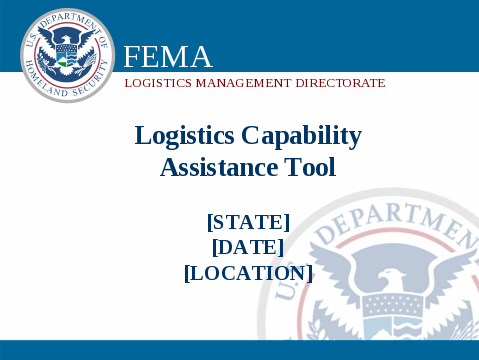
[This is a sample introduction briefing for a Logistics Capability Assistance Tool (LCAT) workshop.]
Good morning. I am [Insert your name, job title, and organization] and as your facilitator, I will guide you through a Logistics Capability Assistance Tool, LCAT assessment workshop.
I would like to thank all of you for being here today. Your attendance and participation will be critical to a successful workshop.
Slide 2
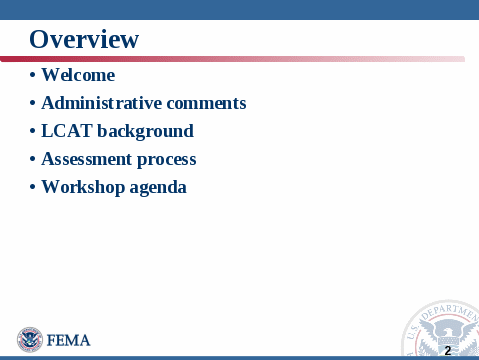
Here is an overview of what will be covered in this presentation. We will end with a quick review of the workshop agenda and then get started on the actual assessment.
Next, [Name, position] would like to welcome you to the workshop.
Slide 3
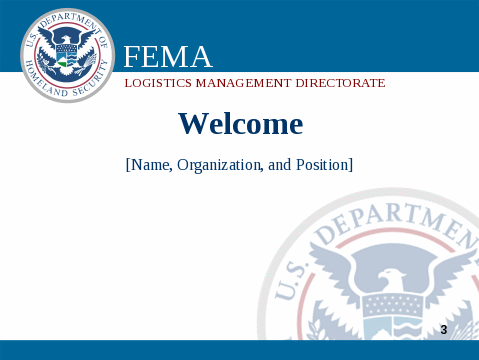
[Add the name of the regional or state representative who will provide the welcome to the slide in the PowerPoint subtitle box.]
[Provide a very short introduction of the person who will provide the welcome, such as name, organization, and position.]
Slide 4

Before we get started, I would like to cover a few administrative items. First, if you have not already signed in please be sure that you do, so that we will have a record of your attendance. At the end of the assessment we would also like for you to complete a survey to help us and FEMA improve LCAT and the assessment process.
[Following are several recommended administrative topics to address:
Facility – Any particular information about the facility, parking, where the restrooms are, etc.
Safety – Evacuation procedures
Messages – Procedures for receiving messages
Introduction – If there are ten or less people in attendance allow everyone to introduce him or herself. If there is a large number of people recognize who is in attendance and state the names of their organization.]
We have planned a fast paced 1-½ days schedule. Our focus will be an efficient, effective, and accurate assessment of your current disaster response logistics capabilities.
Slide 5
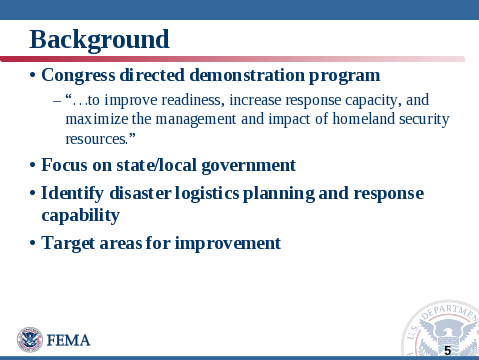
In 2006 Congress directed FEMA to develop and conduct a demonstration program “to improve readiness, increase response capacity, and maximize the management and impact of homeland security resources” for regional and local governments. Launched in 2008 by the FEMA Logistics Management Directorate, LCAT is a pillar of the Logistics Planning, Readiness, and Assistance Program.
Emergency managers at all levels can benefit from conducting assessments and including as many public and private planning and response partners as possible in the assessment process.
The LCAT process has been briefed during logistics planning readiness assistance team visits to regions, regional interagency steering committee meetings, and other meetings and conferences attended by state and local government representatives.
FEMA Headquarters worked with several FEMA regions and states to develop LCAT, a collaborative standardized tool, to evaluate disaster logistics readiness, identify areas for targeted improvement, and develop a roadmap to enhance strengths and mitigate risks.
Slide 6
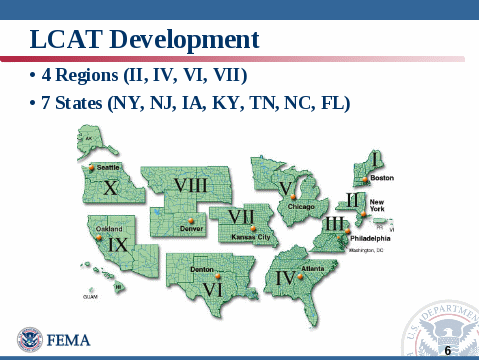
Drawing on input from several FEMA regions and states, LCAT was developed as a collaborative tool to be used to evaluate disaster logistics readiness.
The bottom line is that LCAT was developed by logisticians for logisticians. Logisticians from FEMA Regions two, four, six, and seven along with New York, New Jersey, Iowa, Kentucky, Tennessee, North Carolina, and Florida were instrumental in developing LCAT and ensuring that it is an effective tool.
The four regions and seven states that you see listed here worked with FEMA Headquarters to ensure that LCAT, a stand alone, transportable tool, can also be used to identify areas for targeted improvement and develop a roadmap to enhance strengths and mitigate risks.
Slide 7

Since its launch in 2008, LCAT has been used to help states conduct comprehensive self-assessments of their logistics planning capabilities. By identifying capability gaps and maturity levels, disaster response logistics stakeholders have been able to develop targeted approaches to improve their capabilities.
LCAT is designed to improve the common operating picture for local, state, and federal responders—identifying any gaps between the current state of preparedness and the desired state of preparedness. An added benefit of LCAT and the LCAT workshop concept is the inherent collaboration achieved among state, local, regional governments and agencies and private sector partners who participate in the workshops. Stakeholders gain a more complete understanding of roles, responsibilities, and dependencies; strengthen and build upon existing relationships; and foster new logistics response partnerships. Implementing the tool requires state logistics personnel to work closely with counterparts from other state agencies, the FEMA region and other stakeholder organizations. Sharing information about logistics plans, operational SOPs, and federal, public, and private partner roles and responsibilities not only enhances transparency, but also builds trust among the partners.
Slide 8
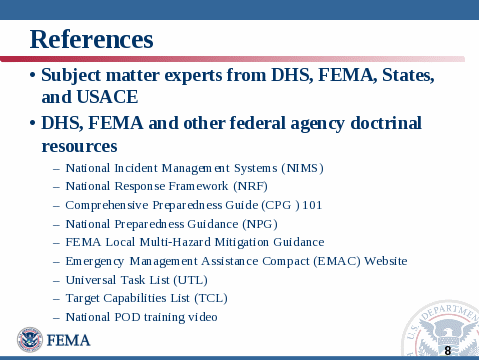
A substantial amount of research was conducted in order to develop a demonstration program that addressed the right issues.
Each of the documents listed here was used to develop LCAT. When we start the actual assessment process you will see the references specific to each survey question annotated.
Though LCAT was created as a result of Hurricane Katrina and the Post Katrina Emergency Management Reform Act of 2006, the goal during development was to create a tool that would be applicable to logistics in any state, region, or disaster.
Slide 9
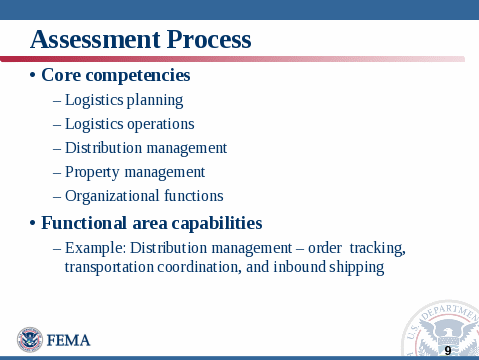
LCAT consists of more than one hundred survey-like questions that are divided into five core competencies: logistics planning, logistics operations, distribution management, organizational functions, and property management.
Each core competency will be assessed by functional capabilities. As an example, distribution management is comprised of the three functional categories shown here.
Slide 10
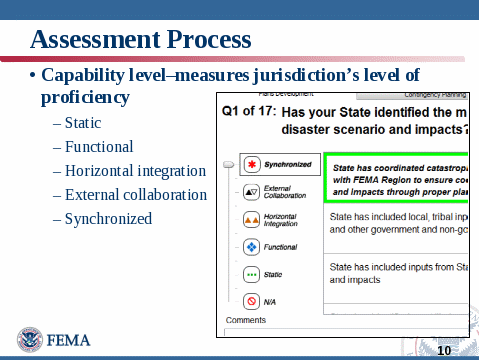
Participants will determine the jurisdiction’s capability level for each question.
As each question is asked there will be an opportunity for the jurisdiction to make a subjective assessment of the capability level for the issue being addressed in the question.
Synchronized - All local, state, federal and private partners have fully integrated and synchronized plans and operation. All SOPs have been documented and exercised regularly with all participants. The state has full mastery of the capability.
External collaboration – The state has coordinated plans and SOPs with other state, local/tribal, and external partner agencies, organizations, and private vendors
Horizontal integration – The state has developed and implemented formalized, integrated SOPs across the emergency management organization
Functional – The jurisdiction has implemented informal plans or processes, but SOPs have not yet been defined or adopted
Static – The state has not yet developed and/or implemented a viable strategy within this functional area
N/A – Process or competency area is not applicable in the jurisdiction
In the example shown in this slide you will see “state” mentioned in the question. As mentioned earlier, the program was initially written for state level assessments. The process is the same for any jurisdiction, so until the local government question set is complete, as we conduct the assessment we will replace “state” with the appropriate description, such as, “city”, “county”, or “tribal government.”
Slide 11
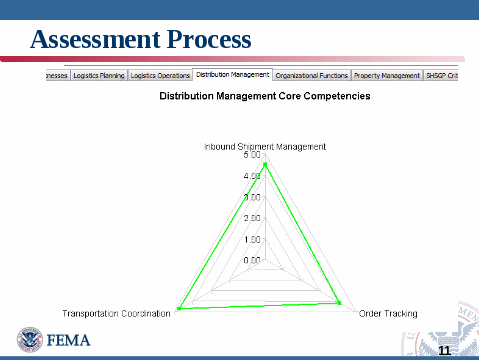
When all of the questions have been answered, LCAT will produce reports and graphs.
There will be a graph showing a capability level for each functional category by core competency. Each functional category will have a valuation based on a scale of 0 to 5.
As an example, this chart shows the capability level for distribution management.
Slide 12
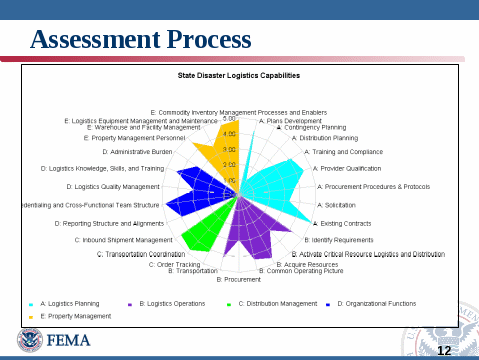
When all of the questions have been answered, LCAT will produce a report and graph for the complete assessment.
What you see here is an example of the results of an assessment. The chart shows pictorially, the capability level for each functional category.
The legend at the bottom of the chart defines the color correlation for each of the five core competencies in the assessment.
Slide 13

This slide is a depiction of the logistics planning life cycle. You will notice that LCAT is an iterative process, meaning that it is a repetitive process. Using today as an example, we are starting with an LCAT workshop. Using the analysis that you will receive as a result of this workshop you can make some decisions about what type of improvements you want to make in a specific area of planning. Through the planning process you may likely identify funding requirements. With factual information from the LCAT analysis you can initiate resource actions. After you have executed or exercised the plans you have created, you then take another self assessment and the process continues. It will be up to you and your jurisdiction to determine at what pace you will move through this planning cycle. However, every step that you take can result in your jurisdiction being better prepared to respond to a disaster.
Slide 14
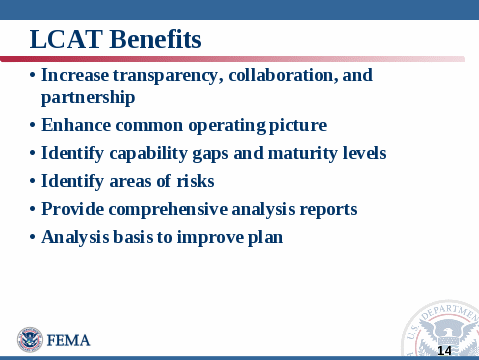
Jurisdictions that have used LCAT for self assessments have proven that taking an honest, critical look at current disaster logistics response planning can have many benefits.
Several of them are listed here.
LCAT assessments provide participants with:
Increased transparency, collaboration, and partnership throughout federal, regional, state, territorial, tribal, and local governments;
An enhanced jurisdiction common operating picture;
Identifiable capability gaps and maturity levels that can be used to improve overall logistics capabilities;
Improved relationships with private partners;
Comprehensive analysis reports provided to jurisdictions;
Increased understanding of the logistics mission and best practices for end-to-end supply chain stakeholders; and
Finally, LCAT analysis reports feed into incident action plans and after action reports (AAR)—ultimately improving plans and mitigating risks.
Slide 15
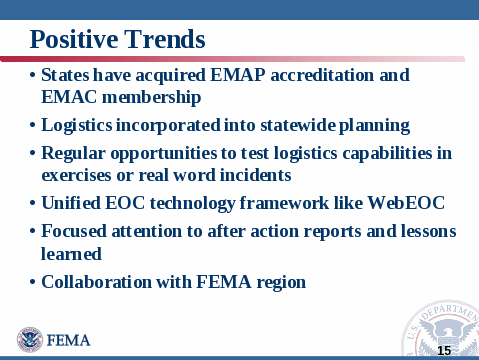
Based on an analysis of previous LCAT assessments that have been conducted several notable trends were identified:
Emergency management assistance: After having participated in LCAT assessments, several states used their analyses as a basis for acquiring Emergency Management Assistance Program (EMAP) accreditation and Emergency Management Association Compact (EMAC) membership.
Logistics planning: Most states emphasized that they have successfully incorporated logistics into their statewide planning efforts, and that they are now generating or planning to produce logistics plans on a regular basis.
Exercises and real-world experience: Most states indicated that they had regular opportunities to test their logistics capabilities, either through exercises or real-world incidents. Some states, however, did desire more such opportunities.
Emergency operations center (EOC) technology: Many states indicated that they had either installed, or planned to install, a unified EOC technology framework such as WebEOC. This technology not only improves intra-state collaboration, but makes it easier to share information with external partners.
Lessons learned and best practices: Most states indicated that they focus attention on generating AARs and collecting lessons learned.
FEMA Regional collaboration: Only one state expressed a need to pursue closer collaboration with the local FEMA Region, suggesting that on a nationwide level, FEMA regional offices have successfully built partnerships with state-level officials.
Slide 16
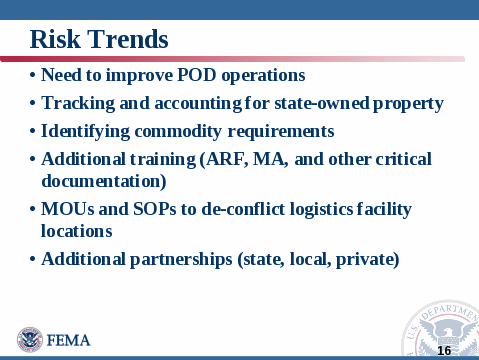
Trends were also identified indicating that some jurisdictions identified risks that should be addressed. If you don’t know where you have risk, it is difficult to make an educated decision about how to either accept or mitigate (reduce) the risk.
To date, points of distribution or PODs are the most common opportunity for improvement among states who have conducted LCAT assessments. There was almost universal agreement that POD operations could be improved through additional outreach to local governments, training, planning, and site identification.
Additionally, many states identified tracking and accounting for state-owned property as an area that needed improvement. This included in-transit visibility during a disaster, as well as access to information on state-owned assets like trucks and material handling equipment. Many states have also indicated that much work is needed to adequately identify commodity requirements, though many also indicated they had begun incorporating hazard modeling from partners such as the USACE.
Another common risk among states was the need for additional training, specifically related to processing Action Requirement Forms (ARF), Mission Assignments (MA), and other critical documentation methods.
States reported that, although they had often identified the locations of state logistics facilities, more progress could be made establishing Memorandums of Understanding (MOU) and SOPs, and de-conflicting those locations with other partners such as FEMA and the National Guard.
Most states indicated that work remained to be done in planning for transportation requirements, which to date had mostly been conducted on an ad hoc basis. Collaboration with private sector and external partners was also a commonly identified area for improvement. States indicated that they wanted to pursue additional partnerships with state agencies, local governments, and private sector partners.
Slide 17
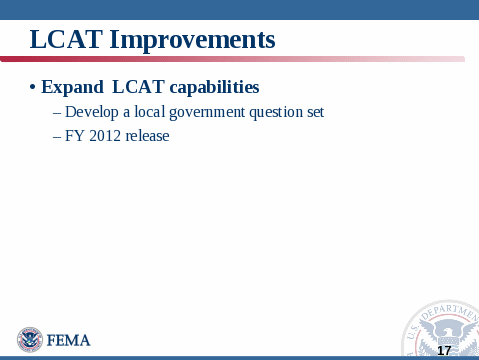
Due to the success of LCAT, FEMA LMD will expand the program to provide disaster logistics assistance to a wider audience including local governments -- cities, counties, and tribal governments. An additional question set for local jurisdictions is being developed and is expected to be released in FY2012. To help validate the local government question set, several cities and counties have expressed an interest in working with their states and FEMA headquarters logistics personnel to test the local government questions.
Slide 18
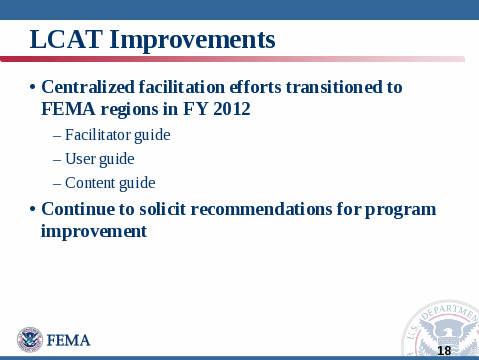
FEMA LMD will begin transitioning LCAT facilitation to FEMA regions in fiscal year 2012. While the FEMA headquarters program office will retain responsibility and control of all modifications to the LCAT content, regional logistics chiefs will act as the primary LCAT facilitators. LMD personnel will provide technical assistance to the regional logistics chiefs as required.
LMD will also provide training in the form of several resources documents: facilitator, user, and content guides that can assist jurisdictions in conducting assessments.
The facilitator guide will help facilitators lead jurisdictions through an LCAT workshop. The guide will provide suggestions for each stage of the workshop, helpful hints for how to interact with participants, and outline the benefit of the LCAT itself.
The user guide will help users install and use the LCAT software.
The content guide will help the user understand the intent behind the LCAT questions and will provide recommended approaches for responding to the questions.
LMD will continue to solicit recommendations from participants on how to improve the LCAT process.
Slide 19
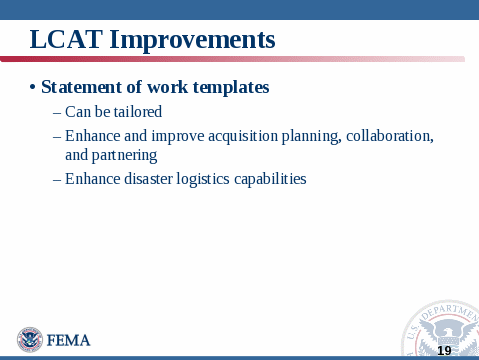
To facilitate improvements, LMD will develop acquisition support templates that jurisdictions can easily tailor to meet their specific needs.
The statement of work templates could be used to enhance and improve acquisition planning, collaboration, and partnering and enhance disaster logistics capabilities.
Slide 20

Here is the agenda for the rest of the workshop. We have a lot of information to cover so I will work hard to keep us on schedule. Each of you should have a hard copy of the agenda.
Before we get started I want to set some guidelines for the workshop.
1. The only right answer is the honest answer. You won’t do your jurisdiction any favors by inflating your responses. Let’s be frank and open.
2. All of you are encouraged to participate. As a matter of fact, we need each of you to participate. Each of you has valid opinions and insights. The benefits from the workshop dialogue and discourse will flesh out some of the nuances of disaster logistics processes.
3. We will need to stay on track so I will monitor time closely. Also, we will note potential improvements to LCAT. The FEMA LMD team is very interested in your input or suggestions for improving the assessment process.
Slide 21
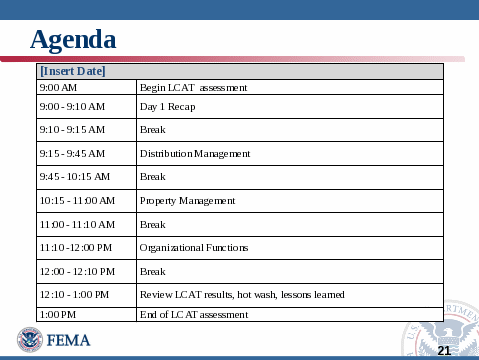
4. Keep conversations focused on the topic of discussion and save cross talk discussions for more appropriate times.
5. Unresolved issues will be moved to the “parking lot” if we can’t reach consensus in an acceptable amount of time. Parking lot issues will be addressed after all of the other questions have been answered.
There will be a recorder capturing your comments for each of the over 100 questions real time in LCAT. Please speak clearly and be patient if we ask you to explain what some anonyms are. As you well know, each jurisdiction is different. A hot wash will be conducted at the end of the workshop to review discussions, responses, action items, and parking lot issues.
Slide 22

Does anyone have questions or comments?
| File Type | application/vnd.openxmlformats-officedocument.wordprocessingml.document |
| File Title | Federal Emergency Management Agency – Logistics Management |
| Author | wfair |
| File Modified | 0000-00-00 |
| File Created | 2021-01-28 |
© 2025 OMB.report | Privacy Policy